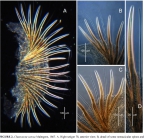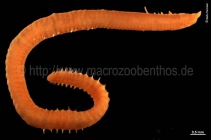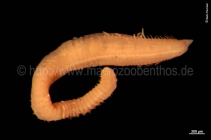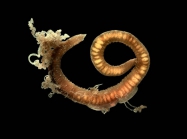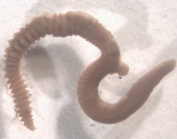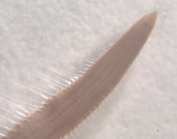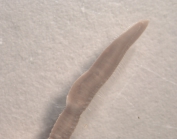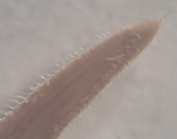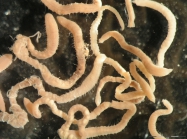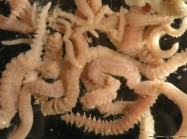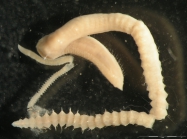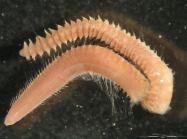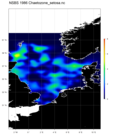
| Introduction | | Search taxa | | Taxon tree | | Taxon match | | Checklist | | Literature | | Stats | | Photogallery | | OBIS Vocab | | Log in |
CaRMS taxon detailsChaetozone Malmgren, 1867
129242 (urn:lsid:marinespecies.org:taxname:129242)
accepted
Genus
Chaetozone setosa Malmgren, 1867 (type by monotypy)
marine,
recent only
feminine
Malmgren, A.J. (1867). Annulata Polychaeta Spetsbergiæ, Grœnlandiæ, Islandiæ et Scandinaviæ. Hactenus Cognita. Ex Officina Frenckelliana, Helsingforslæ. 127 pp. & XIV plates., available online at http://www.biodiversitylibrary.org/bibliography/13358
page(s): 96 [details]
Distribution Species known for European waters. According to Blake & Lavesque (2017: 572) "... only six species of
Chaetozone have been...
Distribution Species known for European waters. According to Blake & Lavesque (2017: 572) "... only six species of Chaetozone have been well described and documented from European waters: C. setosa Malmgren, 1867, the type species; C. carpenteri McIntosh, 1911; C. christiei Chambers, 2000; C. corona; C. gibber, and C. jubata Chambers & Woodham, 2003. Chaetozone elakata [Blake & Lavesque, 2017 is] the seventh well-documented species in European waters. Except for C. jubata, which is a deep-water species from depths of 350–1800 m, the other six European species of Chaetozone all occur in subtidal sediments to depths of no more than 100 m." [details] Etymology Malmgren p.96 (book version of article, or 206 in journal) gives the derivation from Greek in a footnote. Transcribing the...
Etymology Malmgren p.96 (book version of article, or 206 in journal) gives the derivation from Greek in a footnote. Transcribing the lettering it refers to 'chaite' feminine, meaning hair, and 'zone' feminine, meaning belt, thus a belt of hair, in reference to the posterior girdle of spines characteristic of the genus. [details]
Read, G.; Fauchald, K. (Ed.) (2024). World Polychaeta Database. Chaetozone Malmgren, 1867. Accessed through: Nozères, C., Kennedy, M.K. (Eds.) (2024) Canadian Register of Marine Species at: https://www.marinespecies.org/carms/aphia.php?p=taxdetails&id=129242 on 2024-04-23
Nozères, C., Kennedy, M.K. (Eds.) (2024). Canadian Register of Marine Species. Chaetozone Malmgren, 1867. Accessed at: https://marinespecies.org/carms/aphia.php?p=taxdetails&id=129242 on 2024-04-23
Date action by
original description
Malmgren, A.J. (1867). Annulata Polychaeta Spetsbergiæ, Grœnlandiæ, Islandiæ et Scandinaviæ. Hactenus Cognita. Ex Officina Frenckelliana, Helsingforslæ. 127 pp. & XIV plates., available online at http://www.biodiversitylibrary.org/bibliography/13358
page(s): 96 [details] taxonomy source Grosse, Maël; Capa, María; Bakken, Torkild. (2021). Describing the hidden species diversity of <em>Chaetozone</em> (Annelida, Cirratulidae) in the Norwegian Sea using morphological and molecular diagnostics. <em>ZooKeys.</em> 1039: 139-176., available online at https://zookeys.pensoft.net/article/61098/list/9/ [details] additional source Fauchald, K. (1977). The polychaete worms, definitions and keys to the orders, families and genera. <em>Natural History Museum of Los Angeles County: Los Angeles, CA (USA), Science Series.</em> 28:1-188., available online at http://www.vliz.be/imisdocs/publications/123110.pdf [details] additional source Bellan, G. (2001). Polychaeta, <i>in</i>: Costello, M.J. <i>et al.</i> (Ed.) (2001). European register of marine species: a check-list of the marine species in Europe and a bibliography of guides to their identification. <em>Collection Patrimoines Naturels.</em> 50: 214-231. (look up in IMIS) [details] additional source Glasby, Christopher J.; Read, Geoffrey B.; Lee, Kenneth E.; Blakemore, R.J.; Fraser, P.M.; Pinder, A.M.; Erséus, C.; Moser, W.E.; Burreson, E.M.; Govedich, F.R.; Davies, R.W.; Dawson, E.W. (2009). Phylum Annelida: bristleworms, earthworms, leeches. <em>[Book chapter].</em> Chapt 17, pp. 312-358. in: Gordon, D.P. (Ed.) (2009). New Zealand inventory of biodiversity: 1. Kingdom Animalia: Radiata, Lophotrochozoa, Deuterostomia. Canterbury University Press, Christchurch. [details] Available for editors redescription Blake, James A. (2015). New species of <em>Chaetozone</em> and <em>Tharyx</em> (Polychaeta: Cirratulidae) from the Alaskan and Canadian Arctic and the Northeastern Pacific, including a description of the lectotype of <em>Chaetozone</em> <em>setosa</em> Malmgren from Spitsbergen in the Norwegian Arctic. <em>Zootaxa.</em> 3919(3): 501-552., available online at https://doi.org/10.11646/zootaxa.3919.3.5 [details] redescription Chambers, Susan J. 2000. A redescription of Chaetozone setosa Malmgren, 1867 including a definition of the genus, and a description of a new species of Chaetozone (Polychaeta: Cirratulidae) from the northeast Atlantic. Bulletin of Marine Science, 67(1): 587-596. [details] identification resource Blake, James A. (2015). New species of <em>Chaetozone</em> and <em>Tharyx</em> (Polychaeta: Cirratulidae) from the Alaskan and Canadian Arctic and the Northeastern Pacific, including a description of the lectotype of <em>Chaetozone</em> <em>setosa</em> Malmgren from Spitsbergen in the Norwegian Arctic. <em>Zootaxa.</em> 3919(3): 501-552., available online at https://doi.org/10.11646/zootaxa.3919.3.5 page(s): 543; note: Key to 25 species from northern areas [details] identification resource Blake, James A.; Lavesque, Nicolas. (2017). A new species of <em>Chaetozone </em>(Polychaeta, Cirratulidae) from the Bay of Biscay offshore France, together with a review of <em>Chaetozone </em>species from the North Atlantic and adjacent waters. <em>Zootaxa.</em> 4312(3): 565-579., available online at https://biotaxa.org/Zootaxa/article/view/zootaxa.4312.3.10 note: key and tabulation of characters [details] Available for editors  Present Present  Inaccurate Inaccurate  Introduced: alien Introduced: alien  Containing type locality Containing type locality
From editor or global species database
Diagnosis Blake (2015:504) "Prostomium blunt to conical, peristomium elongate to short, usually lacking eye spots, with a pair of small nuchal slits or depressions at posterior edge; with a single pair of grooved dorsal tentacles arising from posterior edge of peristomium, or sometimes more posterior on an achaetous anterior segment, or rarely an anterior setiger. First pair of branchiae arising from an achaetous segment or first setiger; or sometimes with first two pairs of branchiae on a single anterior segment. Body basically thick and fusiform over many segments, rarely with middle or posterior body segments beaded or moniliform. Chaetae include capillaries on most setigers and acicular spines in neuropodia and/or notopodia, spines typically concentrated in posterior segments, forming distinct cinctures with spines emerging from elevated membranes; cinctures with few to many spines and with none to many alternating capillaries; some species with posterior noto- and neuropodial sigmoid acicular spines numerous, encircling entire posterior parapodia; bidentate spines sometimes present in juveniles or occasionally in ventral most position of far posterior setigers of adults accompanying unidentate spines in cinctures; some species with long, natatory-like capillaries, sometimes limited to gravid individuals. Pygidium a simple lobe, disk like, or with long, terminal cirrus [details]Distribution Species known for European waters. According to Blake & Lavesque (2017: 572) "... only six species of Chaetozone have been well described and documented from European waters: C. setosa Malmgren, 1867, the type species; C. carpenteri McIntosh, 1911; C. christiei Chambers, 2000; C. corona; C. gibber, and C. jubata Chambers & Woodham, 2003. Chaetozone elakata [Blake & Lavesque, 2017 is] the seventh well-documented species in European waters. Except for C. jubata, which is a deep-water species from depths of 350–1800 m, the other six European species of Chaetozone all occur in subtidal sediments to depths of no more than 100 m." [details] Etymology Malmgren p.96 (book version of article, or 206 in journal) gives the derivation from Greek in a footnote. Transcribing the lettering it refers to 'chaite' feminine, meaning hair, and 'zone' feminine, meaning belt, thus a belt of hair, in reference to the posterior girdle of spines characteristic of the genus. [details] Grammatical gender Chaetozone is feminine, as both Greek words are feminine and Malmgren used a feminine ending for C. setosa, the type species. [details] From other sources
Habitat Known from seamounts and knolls [details]
|
